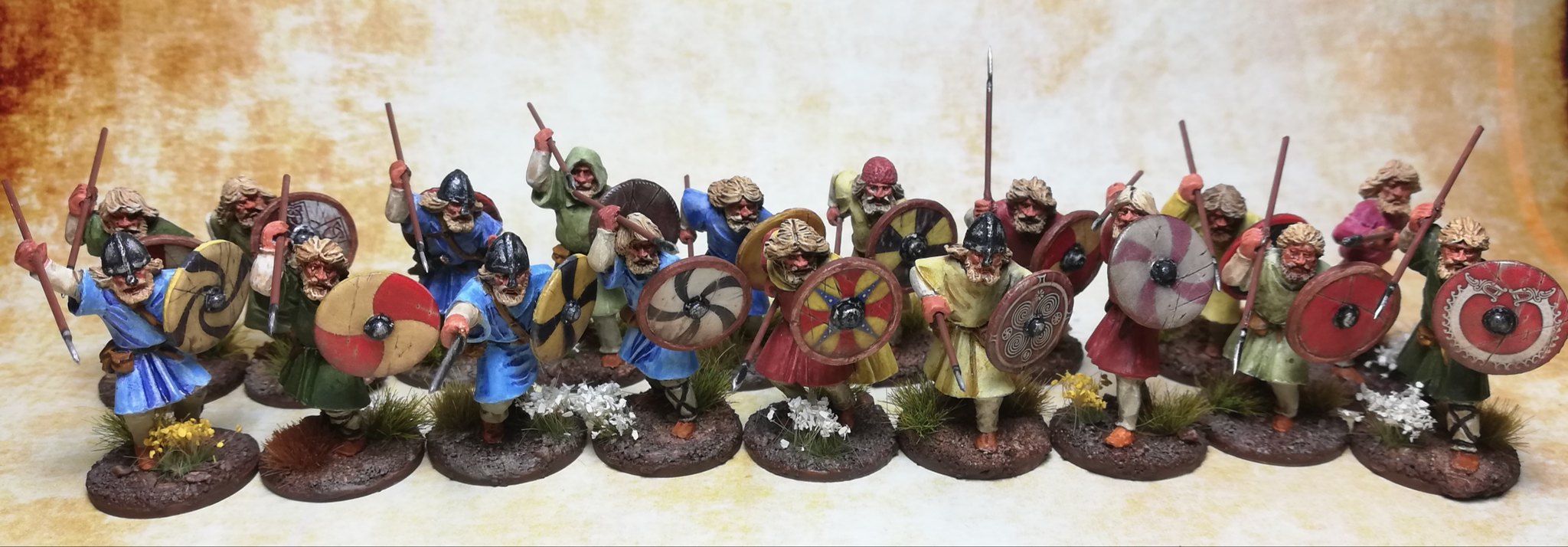I finally got round to testing out the sabot basing method that I've carried in my mind for months. I've documented it below as an aide memoire and in case anyone else can benefit or improve on the method.
Here's the finished result:
This is a 12cm-wide sabot base intended to serve for Impetus, To the Strongest, Hail Caesar, Dux Bellorum and any other element-based game I care to play.
The Steps
1. First, stick some thin magnetic sheet down on MDF. Above is a 1mm magnetic sheet from Popular Bookstore (the stuff from Daiso is too weak) glued with PVA to 3mm MDF. I'd prefer 2mm MDF, but its not available locally and this stuff was custom cut cheap in bulk by a local framing shop.
Arrange the minis into a comfortable formation, particularly so their spears don't poke each other.
Then, mark the position of each figure with a 20mm steel washer, which acts as a placeholder. You don't want to mess up your nicely based minis with raw filler and sand!
You can see them above under the painted minis. I base all my figures on 20mm washers so the magnetic system works. The washers have the advantage of being heavy enough to keep even the most unbalanced figure upright.
2. Apply a layer of filler around the placeholder washers. Liberally sprinkle this over with fine to coarse sand while its still wet. You can always brush water on the semi-dry filler to help the sand adhere. Leave to dry and shake off the excess sand. If there are any bare areas just touch them up with PVA and sand. I use coloured filler which is close to Sienna in colour. It is less troublesome to use than white filler which really sucks up any pigment or paint added.
When that's all dry seal the whole lot with watered-down PVA glue. This gives you a good surface to paint and drybrush the sand without it all coming off.
3. Basecoat with a preferred earth colour. I used a mix of Dark Chocolate and Burnt Sienna from Americana craft paints because they're cheap.
Then drybrush with a sand colour. I used Americana Sand with a few drops of the basecoat to tie them together.
Once that's dry, remove the placeholder washers and clean up their sockets. Make sure there is a good level and even fit for the models' bases or else the magnet won't be as effective. You may have to scrape around the cavity with a blunt sculpting tool to get a good fit. Don't make it too roomy, you want to minimise the appearance of sabot holes. Just enough for a snug but easy fit.
Then you can flock and dress the base. I recommend doing this with the figures inserted so you can disguise any obvious signs that this is a sabot base. I tried to place flock in front of the gap between the sabot and the miniature's base.
As you can see above the front row is quite well disguised. The second row could use a bit more work, but this could easily pass as a nice multi-based unit for Impetus. A future challenge would be to combine some diorama action with sabot basing.
The Test
So, how well do the magnets hold?

Pretty well, I'd say.
Next Steps
In pursuit of an ever-lower base profile I plan to order some 12cm wide, 2mm deep laser-cut MDF bases from Warbases. I will use thin magnetic sheet for the bottom which carries with it the dual advantage of holding both the models and the entire base to a box lined with magnetic sheeting.
My models, based on 20mm-wide washers should sit flush with the MDF. Total depth of base to the foot of the model should be 3mm versus the 5mm in the method above.
As mentioned above, aesthetically I'd like to try some diorama action, perhaps incorporate some drama with casualty figures, or even terrain like a road or other feature to make any given base look less like a movement tray and more like a thoughtful composition.










